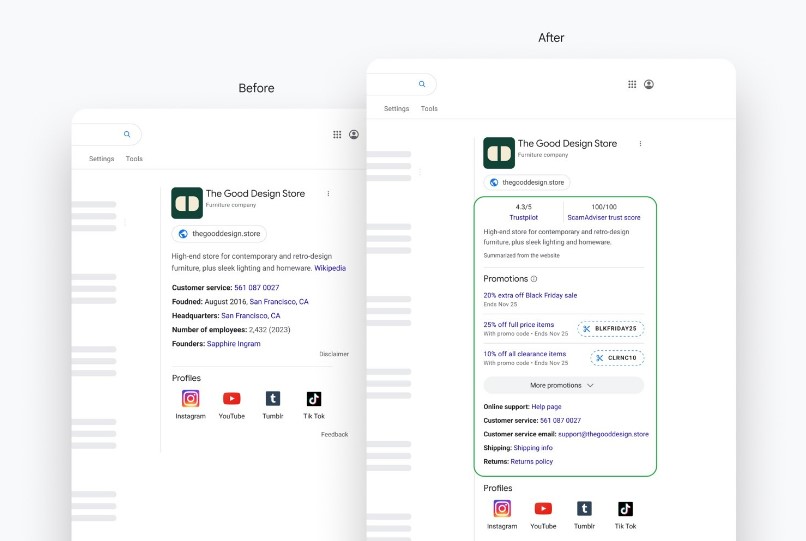Google Aims New Shopping Tools at Boosting Small Business Sales

People want to make conscious choices and contribute to the success of local and independent enterprises. This inclination to “shop small” is driven by various factors, including a desire to nurture the local economy, promote unique and artisanal products, and build a stronger sense of community.
In response to this consumer demand, brands and retailers are seeking ways to make it easier for customers to identify, engage with, and support small businesses. Google has recently joined the ranks of those responding to this demand with the introduction of new initiatives through Google Shopping.
In a recent interview, Matt Madrigal, Google’s vice president and general manager for merchant shopping, shares insights with PYMNTS CEO Karen Webster regarding the company’s newest features, which have been launched in time for the holiday season, and how they’re helping merchants create an impact.
“Today’s newest features are all about, how do we help small businesses put their best foot forward and connect with as many customers as they can,” Madrigal said.
The announcement includes three main elements.
Easier to Find Small Businesses
The first is the “small business attribute.” The holidays are a time when it can be challenging for consumers to find and shop at new small businesses. To address this, the small business attribute permits merchants to prominently display their small business status on Search and Maps.
Madrigal explained the importance of this feature, pointing out that 84% of consumers prioritize supporting local and small businesses. This feature helps users quickly spot products and distinguish small businesses among the list of merchants.
As part of this initiative, a subset of merchants and their products will receive automatic labeling, factoring in criteria like product count and web traffic. Small businesses will also have the flexibility to opt in or out through Merchant Center or Google Business Profile. For those on Shopify or Etsy, Google has partnered with both platforms to identify eligible sellers.
Maximizing Google Business Profiles
Madrigal noted that in 2022, Google Business Profile supported more than 2.3 billion free connections each month, including maps, directions, and phone calls. Furthermore, over the last two years, the number of product listings in Google’s Merchant Center has doubled, resulting in a vast global inventory of 35 billion product listings. With that, the Google team is hoping its next new feature — “knowledge panel for merchants” — will only build upon that momentum.
Madrigal acknowledged that, while the current knowledge panel builds connections, it could be better. Madrigal pointed out that when consumers search for products, the available information often focuses on corporate details that may not be very helpful, like location and employee count, rather than essential details like store hours.
To address this, Google Shopping aims to provide valuable information for all eCommerce businesses, regardless of their size, with a focus on aiding shoppers’ decision-making through it knowledge panel for merchants tool.
“We will display returns policies in the U.S. We’ll also showcase promotional details, including promotions and deals, as well as the various channels available for engaging with this specific merchant, including customer support channels, etc.,” Madrigal said.

Madrigal said this feature enriches the information accessible to shoppers when they search for specific merchants on Google Search and will bolster consumer trust and familiarity with businesses.
Regarding valuable data for merchants, Google has made an investment in providing free market insights to aid in inventory management and purchasing choices. These insights offer predictive information on consumer demand based on search data. For example, merchants can identify high-demand products or categories during specific periods, like the holiday season, to inform their decisions and pricing strategies. These analytics are accessible to all merchants, with a particular advantage for small businesses.
Google’s AI Bid for Merchants
Google introduced Product Studio in May, designed to simplify the creation of distinctive product imagery for merchants by harnessing the capabilities of generative artificial intelligence (AI). As a result, Product Studio has made it easier for merchants to generate captivating and unique visuals.
“Our goal in building tools for merchants is to bring Google’s unique expertise to merchants at scale and help them grow their business in a time when shopping is happening anytime, anywhere,” Madrigal said at the time of the launch.
“We hear from businesses that they find it challenging to stand out and connect with new customers. Eye catching unique content helps grab shoppers’ attention, but creating that content requires a lot of time and resources. Our teams have been building tools to help merchants meet shoppers where they are and put their best foot forward for years.”
Based on Google’s data from April 6, product listings that feature multiple images experience a significant boost in impressions (+76%) and clicks (+32) compared to those with only a single image.
Nevertheless, obtaining a variety of high-quality images can be a costly and time-consuming challenge for many businesses. To address this issue, Product Studio seeks to enable businesses of all sizes to leverage the benefits of generative AI, making it simple to create personalized and distinctive product imagery. Moreover, businesses can access and use Product Studio for free.
Read more: Google Turns Product Images Into Merchant Sales Using Generative AI
In recent months, early testers, including the small business Doppeltree, have been exploring Product Studio. Doppeltree, a skincare company, had a set of basic product images they were fond of, but they required additional content for their social media and eCommerce needs.
Doppeltree Co-Founder Tony Ouyang says that Product Studio’s free generative AI technology “allowed us to diversify our product imagery and produce high quality images in a fraction of the time it would usually take us to do it on our own or hire a photographer.”

